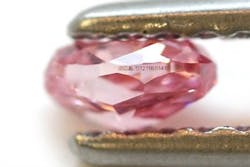Pink diamond's photochromic behavior solved but its color is still a mystery
(Image: Fancy Diamonds)
Crawley, Australia--Scientists at the University of Western Australia have explained the photochromic behavior of pink diamonds in an attempt to learn in detail why they possess their pink color. Natural pink diamonds have defect centers that allow optically controllable and reversible photochromism at room temperature.
“We have pumped these diamonds with various wavelengths of light and measured the response in both time and absorption intensity,” says lead author and PhD student Keal Byrne. “What we’ve seen is that the diamond color -- the amount of absorption that gives it the pink color -- is dependent on both the wavelength and intensity of the light, and what that is consistent with is a model of electron transfer between the unknown pink defect and other defects in the lattice.”
The elusive color center
The pump light causes competing types of photoionization at different defect centers, producing photochromism; the researchers were able to experimentally determine the ionization cross-sections of the relevant defect centers. However, the researchers also found that the defect centers responsible for many other diamond colors (blue, yellow, and others) do not explain how pink diamonds get their color. “Coloration in diamonds is due to crystalline defects in the crystal lattice, which are also known as color centers as they induce color,” says Byrne. “The color center responsible for pink coloration is unknown.”
The team modeled the pink-diamond photochromic process as "an optically-driven electronic transition between two (or more) separate defect trap states, one of which acts as a ground state for the 390 nm and 550 nm absorption bands."1 The depth of the two bands can be reduced under UV illumination, bleaching the diamond; the color can be restored with longer-wavelength light.
“So we’re trying to work out what these new energy levels are that are unique to the pink diamond and by that way we can work out what properties it has and what use it might have,” notes Byrne.
REFERENCE:
K. S. Byrne et al., Diamond and Related Materials, Vol. 30, p. 31, November 2012.
Source: http://www.sciencewa.net.au/topics/industry-a-resources/item/1820-pink-diamond-%E2%80%98behaviour%E2%80%99-solved-but-colour-still-a-mystery.html
